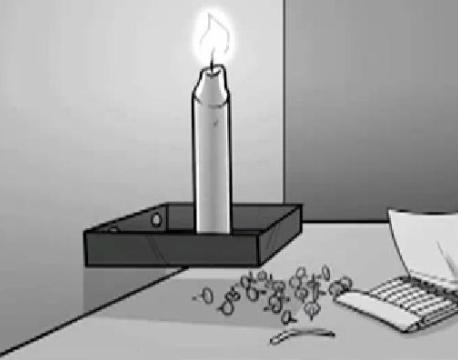
Karl Duncker was a Gestalt psychologist interested in the cognitive mechanisms of problem solving.
In his well-known "candle problem", Duncker first presented a series of objects on a table to each of the participants:
- a candle
- of matches
- a box of thumbtacks
He then asked him to use them to place the candle on the wall so that, once lit, the wax would not drip on the ground.
Many of the participants tried to stick the candle to the wall in various ways and positions, using the pins and the candle wax itself, after having melted it thanks to the matches.
The results were really mediocre, because at best the candle not only dripped to the ground, but fell off after a few seconds.
But very few came to the obvious solution:
- Empty the stylus box
- Attach the box to the wall with the pins themselves
- Put the candle inside the box
- Turn it on and prove that you have solved the problem.
To explain the reasons for this incredible lack of problem-solving skills, Duncker repeated the same experiment with another group of people, varying it in a way that was as small as it was significant.
In fact, the objects were exactly the same, but this time the pins were not inside the box, but outside.
Needless to say, the participants of the second group came very quickly to the solution of the problem, that is to use the box as a candle holder and fix it to the wall with pins.

But why did the participants of the first group, seeing the box of pins full, fail to imagine the solution?
Due to a phenomenon that Duncker called "functional fixity"
Functional fixity
"The functional fixity it is a mental attitude that enables us to see only the solutions that involve the use of objects in the most habitual or usual way. "
In the case of the aforementioned box of pins, seeing it full causes our brain to categorize it immediately:
"Used to put the pins in!"
And then find it hard to free yourself from this first categorization, remaining FIXED on it.
When, however, as happened for the participants of the second group, the brain sees it empty, it categorizes it as potential container of anything.
And therefore it comes naturally to him to think of using it to put the candle inside too.
Functional fixity seems, to rationally observe the candle problem, something truly incredible: how does our brain get stuck and not find such obvious solutions?
Indeed these mental blocks happen to us all the time and in a thousand different areas.
And the functional fixity, which underlies it, has its own profound reason for being.
Generalization of the Duncker candle problem.
To explain the rationale for the candle problem, I have to talk about one of my fixations: human evolution.
Anyone who has been following me for a while knows that, practically every other article, I blame you for some of our many serious flaws.
It is actually because I find it fascinating that, in one way or another, everything has an explanation that starts from the mists of time….
You see, the problem of functional fixity depends on the fact that, in order to think, the brain consumes a disproportionate amount of energy, especially if we put it in relation to the small weight of the organ itself.
Today this is not a problem, on the contrary: just open the fridge to fill up, even in an excessive and unbalanced way, with energy.
But, for most of our evolutionary history, we lived in an environment where food was scarce, and getting energy was complex and tiring.
For this reason, our brain is extremely thrifty when it comes to using it.
And therefore it tends to act through repetitiveness, patterns, pre-established schemes: in fact, these are low-consumption operating modes.
In other words, to save energy our brain has a natural tendency to try to think as little as possible.
In this sense, functional fixity is positive: imagine if, when you have to drive a nail, instead of heading decisively towards the hammer you had to consider every time all the tools in your box.
The problem occurs when, having to solve a slightly more difficult problem, the brain cannot even realize that a box of tacks, once emptied, is an excellent candle holder. .
And don't think the problem is limited to insignificant things like a candle and a box of pins.
Even in everything that is important, and in particular then in adult life, we tend to fixate on a small number of ideas, strategies, methods and solutions, becoming almost blind to the alternatives.
This makes us extraordinarily efficient at all that is repetitive and routine (and this is why it is so important to develop good habits) but potentially very scarce whenever there is a need for an extra flicker of creativity and understanding.
There is a perfect way to balance the tendency to save energy e the need to produce quality analyzes and solutions?
The perfect brain?
If you stick to your routines, you can have a free mind, available to the creative impulse. William James
Contrary to popular belief that genius and recklessness are combined, most people who manage to express their talent do so. cultivating almost monastic habits: they wake up at 5 in the morning, take long walks, keep a detailed diary of their life (perhaps writing it backwards, as Leonardo did).
It is in thinking that, on the other hand, genes go at full speed.
My opinion is that the "perfect" brain is achieved when you manage to be:
- Extremely habitual in actions: in fact, incorporating actions (what we eat, our study and work hours, the amount of sleep, physical exercise) in a series of healthy habits takes away the hassle of having to squeeze the willpower to decide on the trifles. You will go so far on autopilot, without stressing or trying too much. I talk about this in my article on how to increase willpower.
- Extremely NOT habitual in thought: when, in fact, to solve complex problems, we refer to patterns and preconceptions, we inevitably produce low-quality solutions. It is no coincidence in fact to see people persist in making the same mistakes, which from the outside seems absurd, but which instead, as you have seen, is very well explained.
But how do you think in a new and original way?
We will see it now, in the last section of the article, returning to the point from which we started: the problem of the Dunker candle
Insight: seeing from afar and with new eyes
In describing how the participants of the second group were able to easily arrive at the solution, Duncker spoke of a psychological concept known as Insight.
In English it means "internal vision" and roughly corresponds to the term intuition.
I mentioned it when talking about problem solving, about the so-called Eureka moments.
Those in which the light of an idea suddenly comes on in your head (among other things, only I have noticed Duncker's irony, who used the problem of "turning on a light", a metaphor that has always been used to "have an idea?).
Internal vision, however, as a term, I like more than intuition: it gives a precise idea of what happens in this type of phenomenon.
Someone who has just had an insight, for example, is likely to put it more or less like this: "I have been looking at the problem for a while, but I was groping in the dark looking for a solution, when suddenly it appeared clearly in front of my eyes".
As you may have noticed, all the verbal expressions used concern the mechanism of vision.
It is no coincidence: to stimulate insight, in fact, to have intuition, you need to take a step back and take a moment to pause. look at things from afar and with new eyes, redefining:
- The problem
- The individual elements that are part of it
- The relationship between them
To do this, you need to change your point of view, break down the whole into smaller parts, go back to the fundamental qualities of the elements, freeing them from their appearance.
Do you know why the first group of subjects failed to solve the Duncker candle problem?
Why they immediately tried to solve it, using the elements visible and obvious to them: the matches, the pins, the candle.
It would be enough to take a step back, empty the box, take the time to consider the essence of each of those objects, to quickly see the solution materialize before their eyes.
Remember this next time you need to stick a candle to a wall.
A greeting. Armando.


























